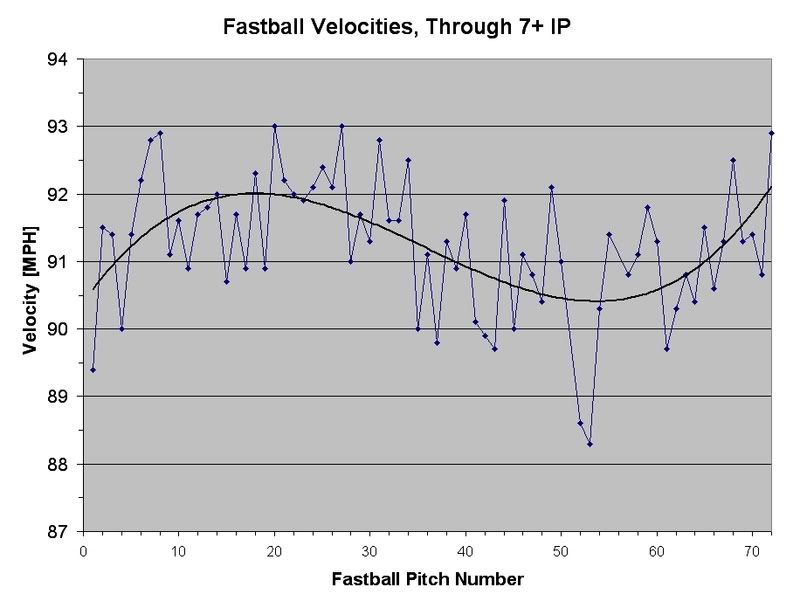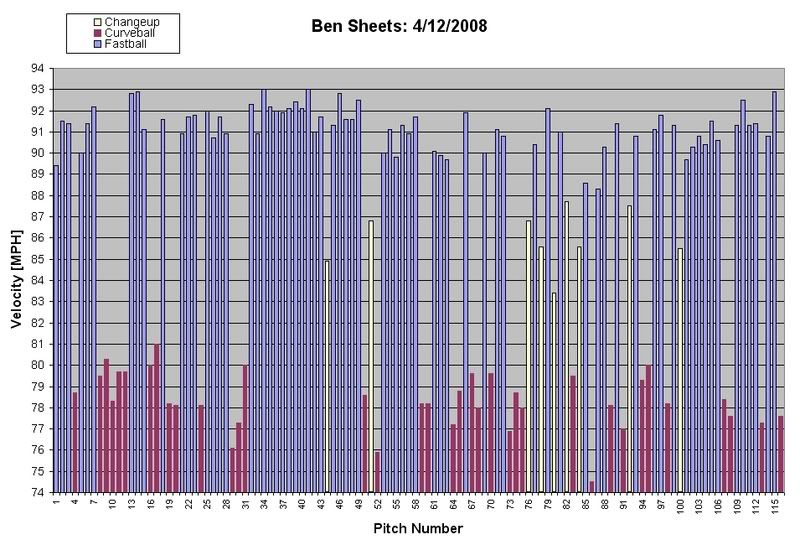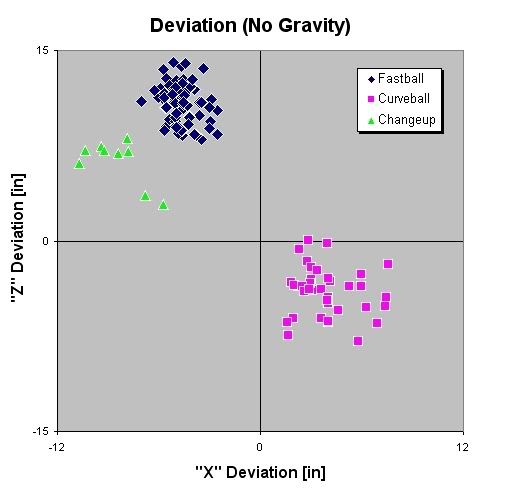Ben Sheets' 3rd Start: Changeup Edition
Ben Sheets is a new Pitch f/x analyzer's dream. The vast majority of the time, he throws a 93-94 MPH fastball and a hard, 12-6 curve. No fancy algorithm is needed to identify either. Well, he had to go and mess that all up by throwing a bunch of changeups during Saturday's 5-3 win.
Sheets has always dabbled with the changeup but this is the first time that I'm aware of that he's ever used it so prominently in a start. It made me actually have to dig into the pitch f/x data and not just rely on Pitch f/x's new pitch identification algorithm. That's probably a good thing, since it's apparently not quite ready for prime time, anyway. As it turns out, even with the changeups, Sheets is a pretty easy pitcher to analyze.
First things first. Let's look at that fastball velocity once again:

Two steps forward, one step back. The average velocity was down and the trend was.... well, there really wasn't one. His velocity usually takes an inning or two to max out but it's odd to see it also spike at the end. Did Sheets decide to give a little extra that last inning? Pace yourself, Ben. It's a long season!
Now, let's look at his velocity for every one of his 116 pitches (click for a larger image):

Sheets threw nine changeups in 7-2/3 innings of work. In contrast, I'd be surprised if he's ever thrown more than two or three in any other start in his career. Here's a summary of the velocities by pitch:
A 5 MPH difference between a pitcher's fastball and changeup isn't anything to boast about but how were the results? Let's take a look:
Hard to argue with those results. The nine changeups resulted in four outs, including two swinging strikeouts. Hopefully, this won't be the last time Sheets has this much success with his 3rd best pitch.
For each pitch, Pitch f/x shows you the distance the ball deviates from the path that it would have traveled with no spin. Using that, it was relatively easy to figure out which pitch was which. There was a total of seven pitches that were misidentified by Pitch f/x by my calculations. Two of Sheets' more mediocre changeups were identified as fastballs (honest mistake) and five of his changeups were identified as curveballs (not so honest). Here is the deviation chart with my pitch identifications:

The view is from behind the catcher, so this chart is showing us that Sheets' changeup rides in on a right handed hitter a bit more than his fastball does, which is typical. Each of Sheet's pitches has a very distinct movement. For other pitchers,it's not quite that simple, though. I guess I lucked out that my favorite pitcher likes to keep things simple, even if he did just make it a little less simple.
I haven't even touched on Sheets' release point yet, which he's supposedly adjusted this year. I have to save something for next time!
Sheets has always dabbled with the changeup but this is the first time that I'm aware of that he's ever used it so prominently in a start. It made me actually have to dig into the pitch f/x data and not just rely on Pitch f/x's new pitch identification algorithm. That's probably a good thing, since it's apparently not quite ready for prime time, anyway. As it turns out, even with the changeups, Sheets is a pretty easy pitcher to analyze.
First things first. Let's look at that fastball velocity once again:

Two steps forward, one step back. The average velocity was down and the trend was.... well, there really wasn't one. His velocity usually takes an inning or two to max out but it's odd to see it also spike at the end. Did Sheets decide to give a little extra that last inning? Pace yourself, Ben. It's a long season!
Now, let's look at his velocity for every one of his 116 pitches (click for a larger image):

Sheets threw nine changeups in 7-2/3 innings of work. In contrast, I'd be surprised if he's ever thrown more than two or three in any other start in his career. Here's a summary of the velocities by pitch:
MPH #
Fastball 91.2 70
Curveball 78.4 37
Changeup 86.0 9A 5 MPH difference between a pitcher's fastball and changeup isn't anything to boast about but how were the results? Let's take a look:
P# CNT MPH RESULT
1: 1-0 84.9 Ball to Delgado (could have been called a strike)
2: 0-0 86.8 Flyout by Church
3: 1-2 86.8 Swinging Strikeout of Beltran
4: 1-0 85.6 Groundout by Delgado
5: 1-0 83.4 Foul ball by Church
6: 1-2 87.7 Ball to Church
7: 2-2 85.6 Flyout by Church
8: 1-1 87.5 Ball to Schneider
9: 2-2 85.5 Swinging Strikeout of AndersonHard to argue with those results. The nine changeups resulted in four outs, including two swinging strikeouts. Hopefully, this won't be the last time Sheets has this much success with his 3rd best pitch.
For each pitch, Pitch f/x shows you the distance the ball deviates from the path that it would have traveled with no spin. Using that, it was relatively easy to figure out which pitch was which. There was a total of seven pitches that were misidentified by Pitch f/x by my calculations. Two of Sheets' more mediocre changeups were identified as fastballs (honest mistake) and five of his changeups were identified as curveballs (not so honest). Here is the deviation chart with my pitch identifications:

The view is from behind the catcher, so this chart is showing us that Sheets' changeup rides in on a right handed hitter a bit more than his fastball does, which is typical. Each of Sheet's pitches has a very distinct movement. For other pitchers,it's not quite that simple, though. I guess I lucked out that my favorite pitcher likes to keep things simple, even if he did just make it a little less simple.
I haven't even touched on Sheets' release point yet, which he's supposedly adjusted this year. I have to save something for next time!




